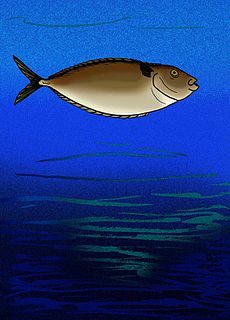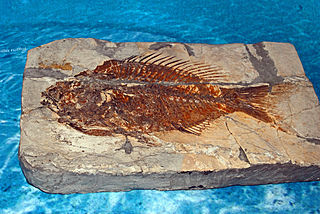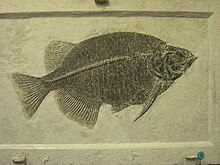
The Esociformes are a small order of ray-finned fish, with two families, Umbridae and Esocidae. The pikes of genus Esox give the order its name.

The Molidae comprise the family of the molas or ocean sunfishes, unusual fish whose bodies come to an end just behind the dorsal and anal fins, giving them a "half-fish" appearance. They are also the largest of the ray-finned bony fish, with the ocean sunfish Mola mola and southern sunfish, Mola alexandrini, both recorded at up to 4.6 m (15 ft) in length and 2,300 kg (5,100 lb) in weight.

Knightia is an extinct genus of clupeid bony fish that lived in the freshwater lakes and rivers of North America and Asia during the Eocene epoch. The genus was erected by David Starr Jordan in 1907, in honor of the late University of Wyoming professor Wilbur Clinton Knight, "an indefatigable student of the paleontology of the Rocky Mountains." It is the official state fossil of Wyoming, and the most commonly excavated fossil fish in the world.

Xenacanthus is a genus of prehistoric sharks. The first species of the genus lived in the later Devonian period, and they survived until the end of the Triassic, 202 million years ago. Fossils of various species have been found worldwide.

Pycnodus is an extinct genus of ray-finned fish ranging from the Jurassic to Eocene periods. As its name suggests, it is the type genus of Pycnodontiformes.

Presbyornis is an extinct genus of anseriform bird. It contains two unequivocally accepted species; the well-known P. pervetus and the much lesser-known P. isoni. P. pervetus was approximately the size and shape of a goose, but with longer legs; P. isoni, known from a few bones, was much larger, more than swan-sized. Other fossils, more doubtfully assigned to this genus, are also known.

Carcharias is a genus of sand tiger sharks belonging to the family Odontaspididae. Once bearing many prehistoric species, all have gone extinct with the exception of the critically endangered sand tiger shark.

Priscacara, is a genus of extinct temperate bass described from Early to Middle Eocene fossils. It is characterized by a sunfish-like body and its stout dorsal and anal spines. The genus is best known from the Green River Formation of Wyoming, Utah and Colorado. Mass deaths of Priscacara suggest it formed schools.
Pseudodontornis is a rather disputed genus of the prehistoric pseudotooth birds. The pseudotooth birds or pelagornithids were probably rather close relatives of either pelicans and storks, or of waterfowl, and are here placed in the order Odontopterygiformes to account for this uncertainty. Up to five species are commonly recognized in this genus.

Ceratoichthys pinnatiformis is an extinct species of lookdown-like prehistoric jackfish that lived during the Lutetian epoch, of the Middle Eocene of Monte Bolca, Italy.

Kushlukia is an extinct genus of prehistoric bony fish, closely related to the luvar, that lived during the lower Eocene. K. permira is from Eocene portion of the Danata Formation Lagerstatten, of Turkmenistan. A second, as yet undescribed species is from the Fuller's Earth formation Lagerstatten in the Barmer District, of Ypresian Rajasthan, India.
Opsithrissops is an extinct genus of prehistoric bony fish that lived during the Thanetian stage of the Paleocene epoch. It is a small 100 centimetres (3.3 ft) nektonic opportunistic carnivore in the family Osteoglossiformes which includes other bony-tongues such as the extant species of Arowana and Arapaima. It hunted small invertebrates and fish similarly to today's trout and became a Paleogene keystone species in many habitats before its disappearance from the fossil record.

Mioplosus is an extinct genus of percid fish that lived from the early to middle Eocene. Five species of the genus has been described, Mioplosus labracoides is found in the Green River Formation Lagerstätte. Mioplosus has numerous extant relatives in Northern Hemisphere fresh- and brackish water, as well as fossil relatives in Asia, Europe and New Zealand, and may be closely related to the modern-day Pike-perches.

Sparnodus is an extinct genus of prehistoric perciform fish in the family Sparidae. Species of this genus were nektonic carnivore. These fishes lived in the Cenozoic Era, in Oligocene and Paleocene.

Macrocranion is a genus of extinct mammal from the Eocene epoch of Europe and North America. Exceptional fossils have has been found in the Messel Pit of Germany. Macrocranion species are often described as forest-floor predators, about the size of small squirrels but with longer limbs. The genus is represented at the Messel Pit site by two species, M. tupaidon and M. tenerum.

Laccognathus embryi is an extinct species of porolepiform lobe-finned fish recovered from Ellesmere Island, Canada. It existed during the Frasnian age of the Late Devonian epoch.

Scatophagus is a genus of ray-finned fishes belonging to the family Scatophagidae. They are found in the Indo-Pacific region. Species in this genus are referred as spotted scats.
Galecyon is a genus of hyaenodont that lived during the early Eocene in Europe and North America.
Wyonycteris is a genus of small mammals that existed in the late Paleocene and early Eocene epochs. The type species is Wyonycteris chalix, which lived in Wyoming during the Clarkforkian North American Land Mammal Age of the Paleocene and was originally proposed to be an early form of insectivorous bat. Later re-examination of the material has put this alliance in doubt, and the genus has instead been proposed as belonging to the subfamily Placentidentinae, within the family Nyctitheriidae. Similar fossil material of the same time period found in Europe was later discovered and described as new species, Wyonycteris richardi.

Cockerellites is a genus of extinct temperate bass described from early Eocene-aged fossils found in the Green River Formation of Wyoming. It is characterized by a sunfish-like body and its stout dorsal and anal spines. The type species, C. liops, was originally named as a species of Priscacara by Edward Drinker Cope upon creating the genus in 1877, but P. liops was moved to the newly created genus Cockerellites by D. Jordan and H. Hanibal in 1923. Some authors, such as Whitlock (2010), still consider Cockerellites liops as a species of Priscacara.




















